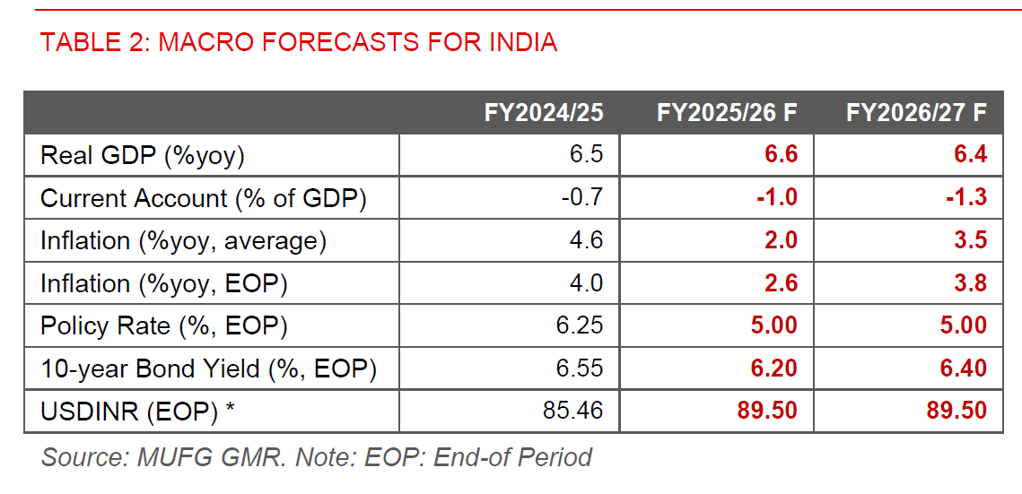- There are a whole host of factors affecting India’s macro and markets right now, many of which pull in different directions, and ranging from tariffs, structural reforms, and policy support. We have written about many of these drivers separately in past research, and we synthesise them in this report (also see link to chartpack published separately).
- Our key messages are that we expect USD/INR to rise towards 89.70 over time, implying INR underperformance against core G10 and key Asian currencies, even as the US Dollar weakens. Nonetheless, we would expect INR weakness to be controlled and modest, and as such with FX vol likely contained given important offsetting impacts of domestic structural reforms and relatively cheap FX valuations in our base case. On the external front, we think it may be difficult for India to strike a meaningful trade deal with the US to lower tariffs substantially. As a working assumption, we see tariffs lowered from the current 50% to 25% by early next year, but emphasise some economic damage would have been done, on top of other risks such as H-1B visa restrictions and ongoing draft legislation to curb offshoring such as the HIRE Act.
- With external headwinds remaining, we continue to forecast RBI to cut rates twice more, bringing policy rates to 5% from 5.50% currently. We think RBI turned more dovish in its Oct policy meeting, while keeping the door open for further rate cuts. We think more room to cut rates will open up over time, with inflation likely coming in lower than the central bank’s latest forecasts.
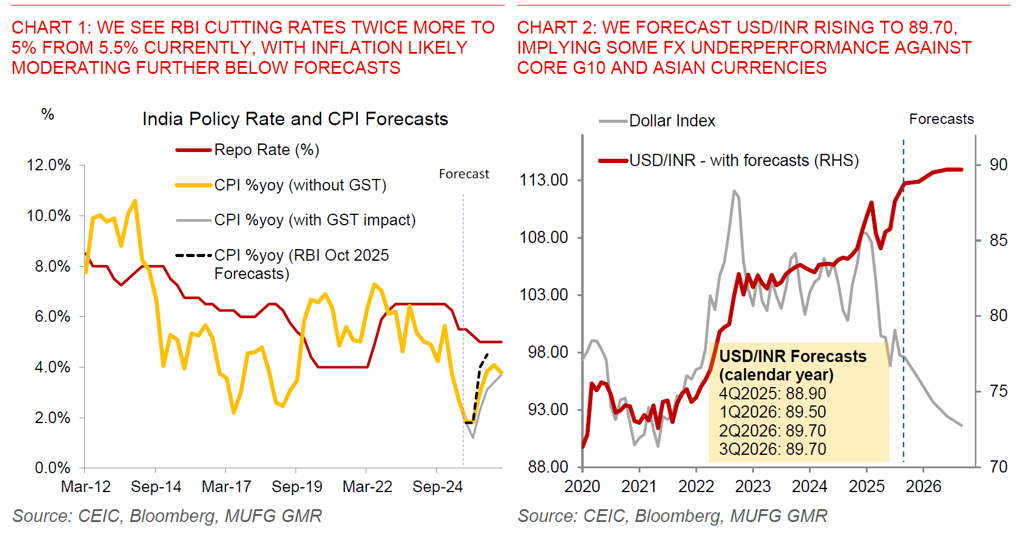
- Beyond the actual rates decision, RBI’s latest October policy meeting was notable for the significant breadth of regulatory and policy changes announced. There were 22 proposed changes in all, encompassing policies to strengthen banking sector resilience, improve credit flow such as allowing banks to finance acquisitions, promoting ease of doing business, simplifying FX management including relaxations on External Commercial Borrowing, and supporting INR internationalisation (more details in report).
- To our minds, these changes might also be another clear marker of a new policy regime under RBI Governor Sanjay Malhotra – one which perhaps tilts somewhat more towards growth, with less micromanagement and being more regulatory friendly.
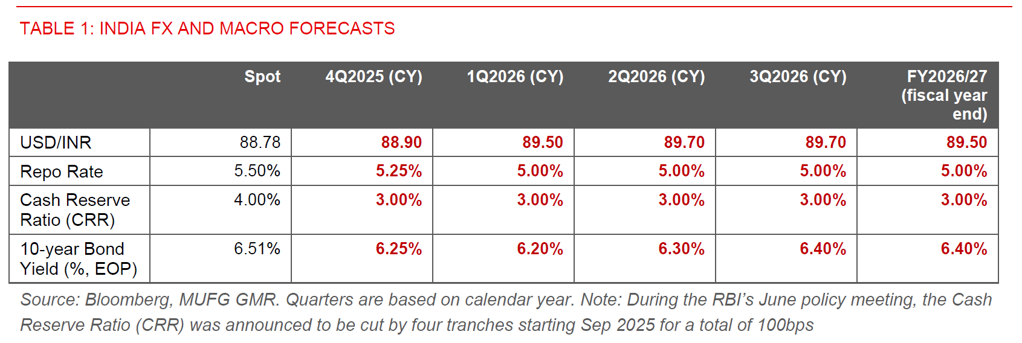
INR to underperform on high tariffs and other policy changes such as H-1B visas
We still expect the Indian Rupee to underperform and growth to be weighed down largely due to external headwinds from tariffs and other policy changes from the Trump administration. All these in turn contribute to a modestly challenging outlook from a FX flow perspective, but offset by important structural reform measures and policy changes both fiscal and monetary taken by India’s authorities.
First, the negatives.
For one, the 50% tariffs by the US administration are a significant negative for India’s exports and growth outlook. Our previous estimates show that the 50% tariffs if sustained could reduce India’s GDP by 1% over time (see India US tariffs – Restore, Rebalance and Reform?). These negative sensitivities reflect multiple factors, including lower existing reciprocal tariffs on India’s major export competitors, India’s high and increasing leverage towards the US end-demand across multiple product lines, and US’ reasonably low reliance on India as a source of import demand and hence the US’ ability to substitute to alternative markets.
In addition, we continue to disagree with the consensus around the small impact of tariffs to India’s economy.
We highlight many of the impacted export sectors such as textiles, gems and jewellery, leather, toys manufacturing, and shrimp production, among others also happen to be labour intensive ones. As such there could be a meaningful social and employment impact for India beyond just the headline GDP hit (see India US tariffs – Restore, Rebalance and Reform?).
In addition, it is just as important to take opportunity costs into account. What is far more impactful for India in our view are the potential lost opportunities in terms of future manufacturing FDI arising from the tariffs, beyond the near-term growth hit. The likely slowing in terms of export-related manufacturing FDI implies an even greater pressing need to create alternative growth drivers, and especially employment-intensive ones given India’s burgeoning population.
As a working assumption, we see tariffs lowered from 50% to around 25% by early next year. The key for markets is that these tariffs are likely to remain higher than India’s key competitors in our view, and with at least some damage to India’s exports and FDI prospects this will likely also weigh on INR from an FX perspective over time.
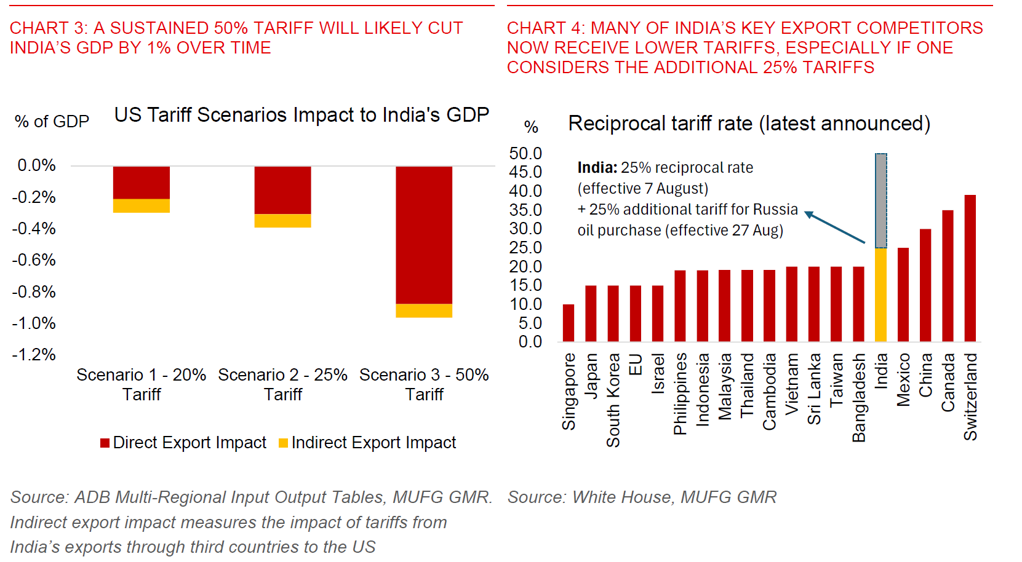
The second key negative for INR arises from recent policy changes in H-1B visas, as such compounding challenges from tariffs (see Asia – H-1B confusion – INR to underperform). The US administration announced that it will be enforcing a US$100,000 fee for new H-1B visa applications starting from September 2025. Across Asia, we have highlighted that India stands out as a country which could be negatively affected disproportionately by these visa changes, with Indians making up anywhere from 50% to 70% of total petitions and new employment H-1B visa approvals. India’s IT service firms are also some of the larger users of H-1B visas historically, in order to help their US clients service their IT and engineering activity onshore. That said, India’s IT services firms have also been reducing their reliance on the H-1B visa over the past 10 years, and so in some ways they have already been preparing for possible tighter immigration policies.
We see these tighter restrictions potentially resulting in slower remittances growth over time. Assuming the flow of total H-1B visa issuance from India declines by half, we estimate overall immigration into the US could slow by around 3%, which could translate to around a 0.1-0.2% of GDP reduction in remittances for India.
Beyond remittances, the impact to India’s IT services export revenues is uncertain from the direct impact of H-1B visa announcements. While India’s IT services companies could see some margin hit from requirements to hire more locally, there could conceivably be some additional activity offshored to India given difficulty of fulfilling all work onshore in the US based on the available talent pool.
The broader macro story picture nonetheless is that these H-1B changes come at the same time as existing challenges for the IT services industry. These headwinds include the impact of slower technology spending by end-clients perhaps due to AI. In addition, there are also ongoing draft legislations in the US such as the HIRE Act to curb offshoring by US companies. If passed, the HIRE Act would impose a 25% excise tax on outsourcing services paid by US companies, with these payments potentially non-deductible for US corporate tax.
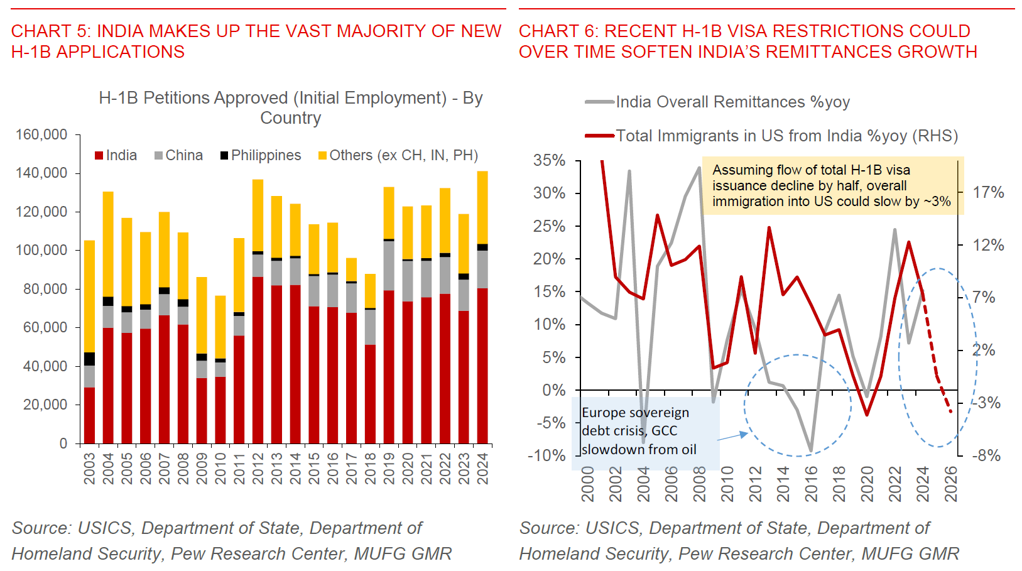
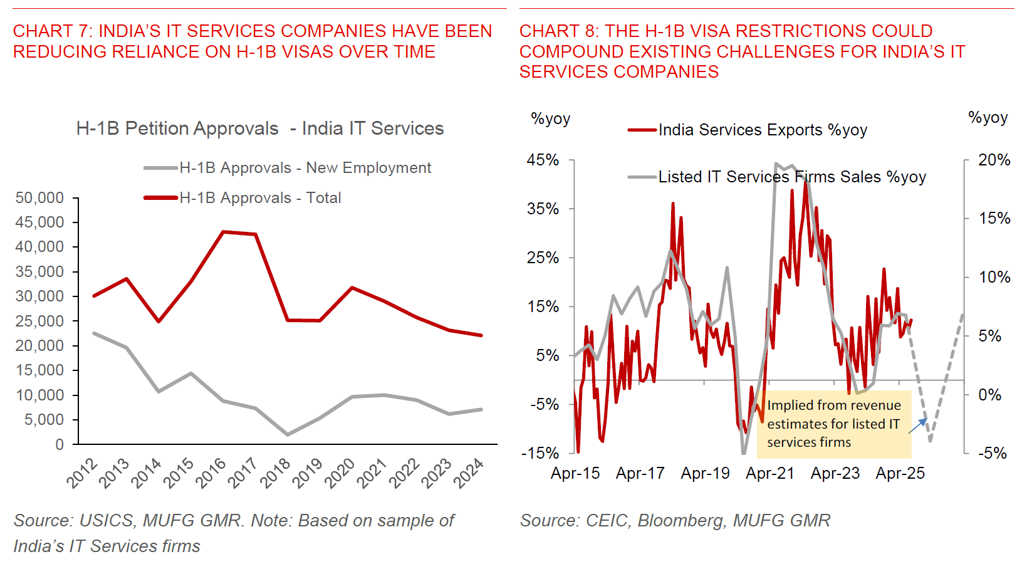
The positives – Reforms including from GST simplification, RBI’s policy announcements, and cyclical support from a decent monsoon
Beyond these external headwinds, our INR FX and rates forecasts also incorporate the offsetting positive impact of domestic structural reforms, including from recent GST tax cuts and simplification, together with RBI’s recent host of regulatory changes to improve credit flow and improve the ease of doing business, among other objectives.
First, India announced its most consequential reforms to the Goods and Services Tax since the system was introduced in 2017 (see India: Most consequential GST reforms since 2017).
In particular, the GST Council – comprising of a panel of federal and state finance ministers – decided to shift to a simpler three-slab tax rate structure of 0%, 5% and 18% to be effective from 22 September. In comparison, the existing GST system has a complex multi-tier system of 5%, 12%, 18%, 28%, and 40%, together with some exemptions for essential goods. The most classic example of the current complexity of India’s GST system is that non-branded popcorn mixed with salt and spices attract a 5% GST, pre-packed popcorn 12%, and caramel popcorn at 18% due to its added sugar content.
Chart 9: India’s GST council decided to shift to a simpler 3 tax rate structure from the previous multi-tier system
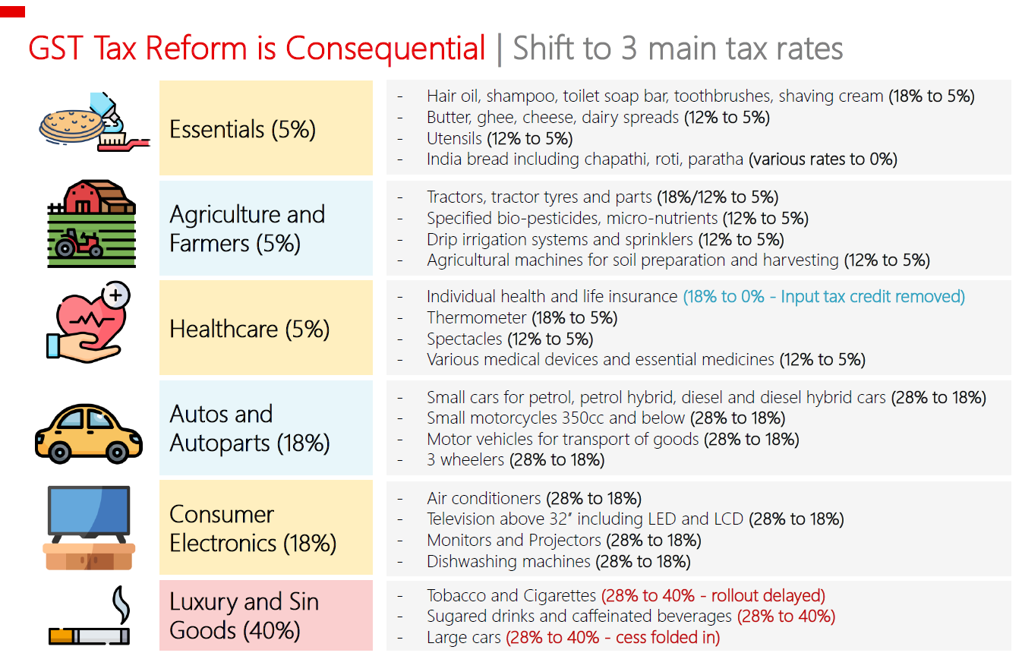
Source: India PIB, Various News Articles, Bloomberg, MUFG GMR. Note: Selected items and tax changes
As a generalisation, everyday items such as shampoo, toothpastes, butter, among others have been shifted to 5% from 12% previously. Some other items which are deemed important for groups such as farmers and in the healthcare space such as tractors, thermometers and life insurance have also either been zero-rated or shifted to 5%.
Meanwhile, consumer durables are generally at a higher rate of 18% but also importantly see tax cuts, with items such as air-conditioners, televisions, motor vehicles and motorcycles (non-luxury), shifted to 18% from 28% previously. There are some sin goods including cigarettes, added-sugared drinks, aircrafts for personal use which are now taxed at 40% from 28% previously.
Net-net, we see these changes to GST lowering inflation by around 0.7pp over time (assuming 70% pass-through from the tax changes), while the fiscal deficit could widen by around 0.3-0.4% of GDP without offsetting spending and revenue changes. In terms of growth impact, we think the GST changes could raise GDP growth by around 0.4-0.5% of GDP, which together with earlier announcements of personal income tax cuts should provide an important offset to the negative impact of tariffs.
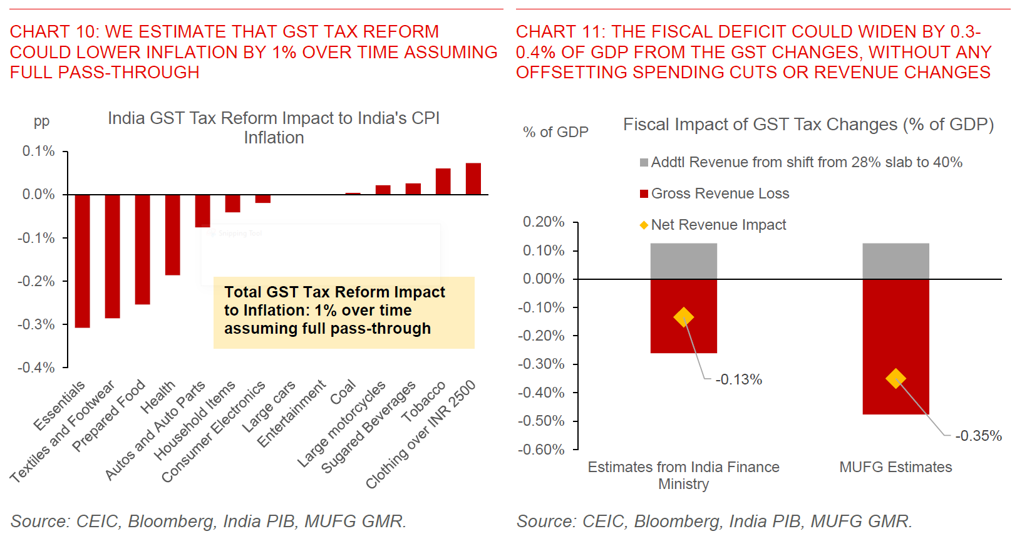
Beyond the GST reforms, RBI’s recent policy meeting in October 2025 was also notable for a whole host of regulatory reforms that the central bank announced. These measures encompass a wide range of measures, from strengthening banking sector resilience, improving credit flow to the economy, promoting ease of doing business, simplifying FX management including easing External Commercial borrowing regulations, enhancing consumer satisfaction, and measures to support internationalisation of the Indian Rupee (see Chart 12 below).
Notable policy proposals include allowing banks to finance corporate acquisitions, potentially lowering risk weights for MSMEs and residential real estate loans, relaxing limits for lending against securities and infrastructure, coupled with easing up on External Commercial Borrowing (ECB) regulations. While these measures will take some time to flow through to the economy, in general we think the policy direction of easing credit and regulatory measures, coupled with de-regulation are overall supportive of growth and provides another offset to tariffs.
Chart 12: RBI announced substantial policy changes in its October 2025 policy meeting
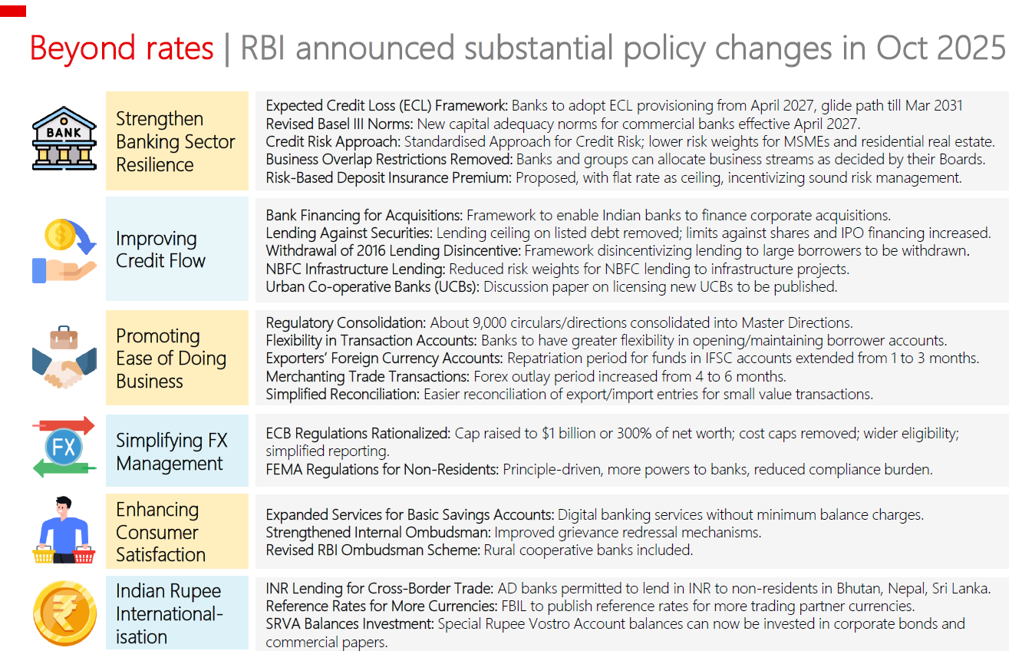
Source: RBI Oct 2025 Monetary Policy, RBI Oct 2025 Statement on Developmental and Regulatory Policies, Various News Articles, Vinod Kothari Consultants, MUFG GMR. Note: RBI’s policy proposals, compiled for information purposes
Chart 13: External Commercial Borrowing regulations proposed to be relaxed
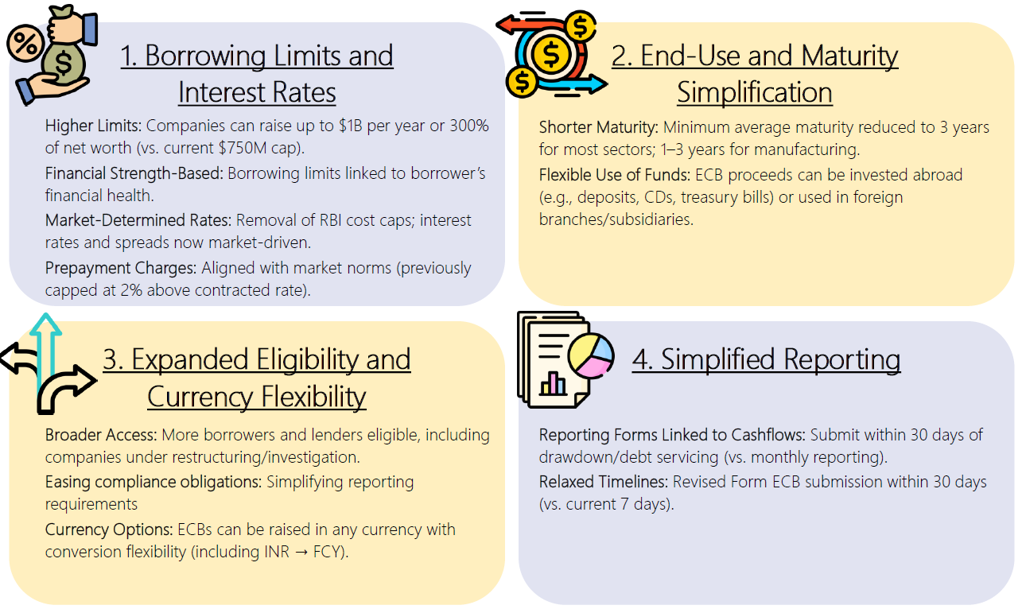
Source: RBI Oct 2025 Monetary Policy, RBI Oct 2025 Statement on Developmental and Regulatory Policies, Various News Articles, Vinod Kothari Consultants, MUFG GMR. Note: RBI’s policy proposals, compiled for information purposes
While it’s still early days of course, the latest high frequency indicators we have for October, together with anecdotal feedback from companies from news articles suggest that festive sales have been strong, supported by policy measures including GST tax cuts. For instance, registrations for passenger vehicles, two-wheelers, and tractors all registered sharp jumps in October based on the latest data that we have on hand. There were reports from a variety of brands and retailers, with many showcasing some of their highest Navratri sales in over a decade, ranging from 25 to 100% growth. The GST reforms and tax changes are reported to be an important contributor to the festive sales strength. In addition, we also think that underlying cyclical factors such as a decent Monsoon, good Kharif sowing and the moderation in inflation thus far continue to be domestic supports for demand outside of external tariff related risks.
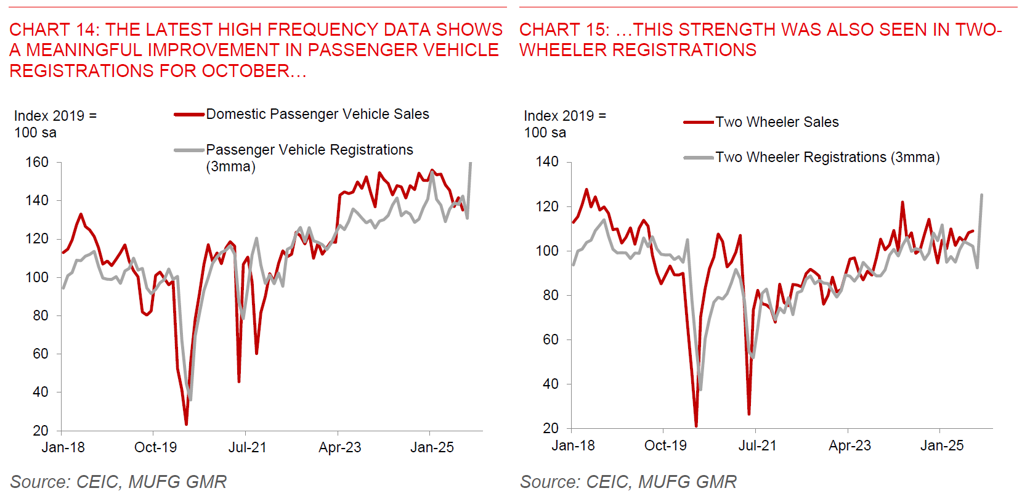
We forecast USD/INR to rise to 89.70, FX vol should remain contained, while RBI to cut rates twice bringing the policy rate to 5% from 5.50%
In the broader context of these push and pull factors, the flow picture for INR has not been too supportive, and as such we think managed INR weakness and underperformance continues to make sense. We have continued to see foreign equity outflows, higher FDI repatriation driven in part by a still strong pipeline of IPO listings, coupled with an expectation of a wider current account deficit from weaker exports, softer remittances, and a slowdown in IT services exports.
Our best sense is that INR FX and rates markets are awaiting the next legs of domestic policy reforms, even as they have built in some of the upside and downside risks of these various factors we have mentioned.
As such, we continue to think that a modest rise in USD/INR with INR underperformance makes sense, with the current and future trajectory of domestic structural reforms an important offset to external risks from tariffs. FX valuations are also quite cheap with a fall in the INR Real Effective Exchange Rate (REER) below its long-term averages, and so we are hesitant to be too bearish on INR at current levels.
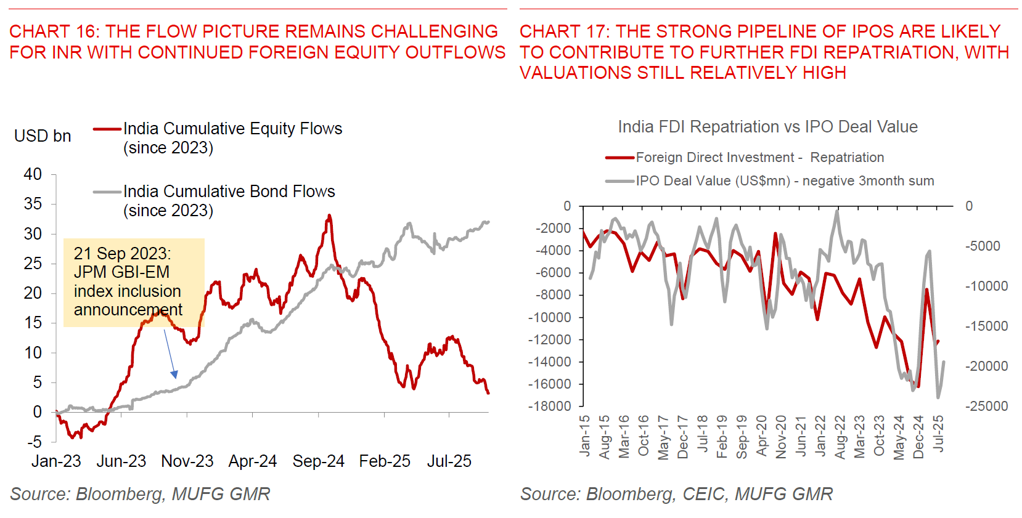
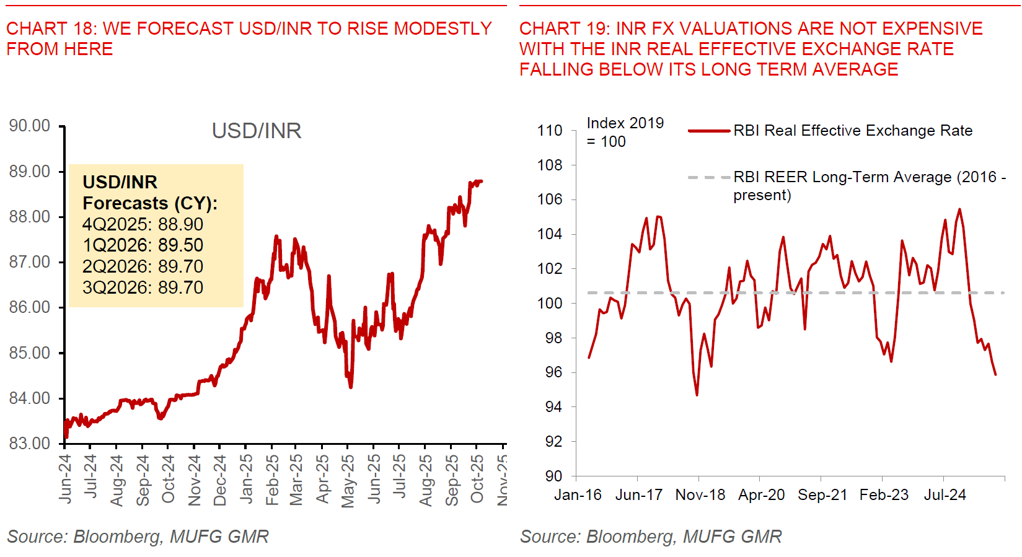
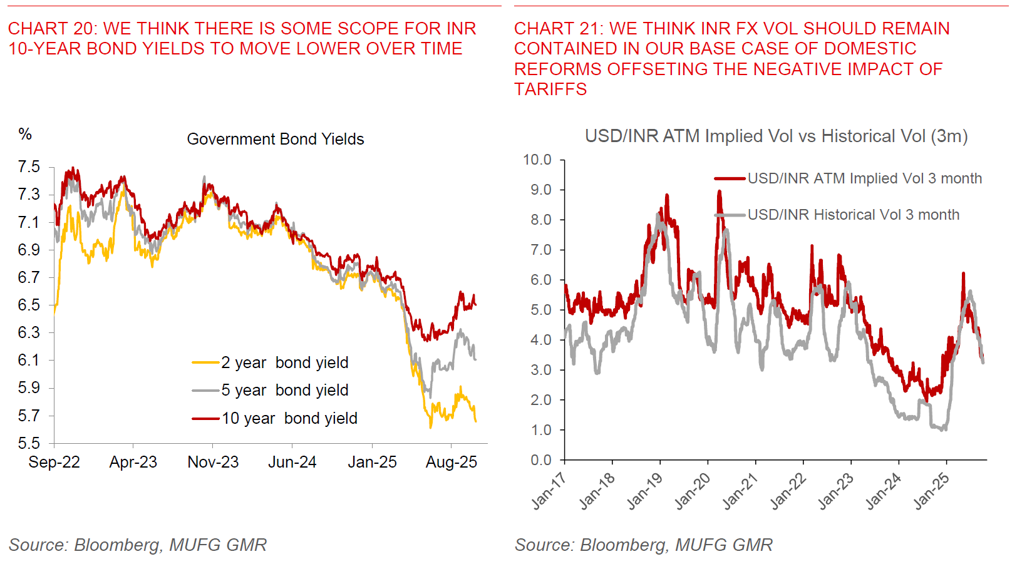
Appendix
